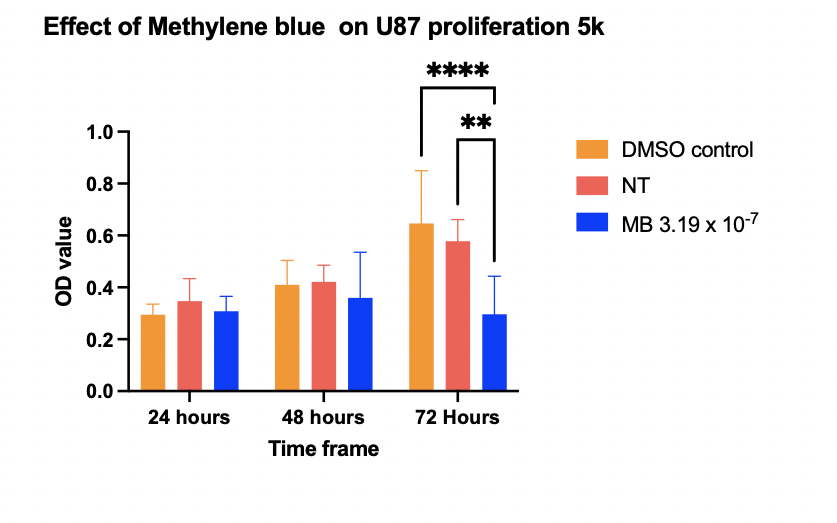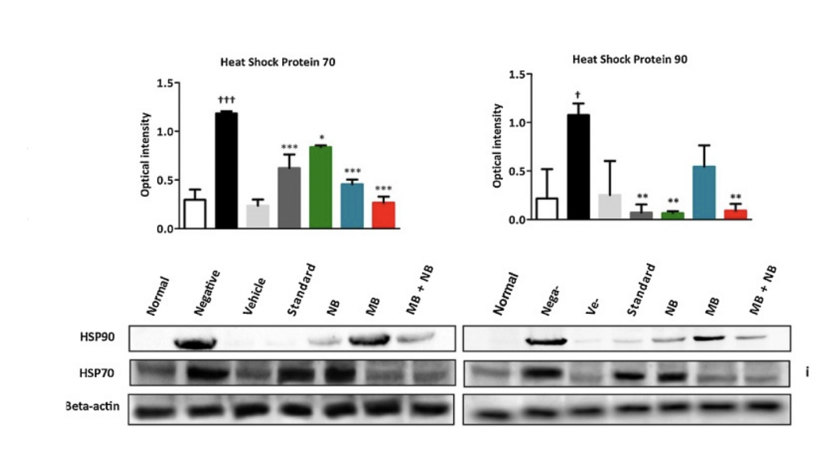Methylene blue and the big C
Happy New Year to you all. As it seems impossible to get any decent time for writing blogs and consistent posts whilst doing research. I am going to try and just drop small articles when I can.
The first to kick off the new year was prompted by seeing a Joe Rogan-Mel Gibson interview, where the latter offered some anecdotal evidence that amongst others, methylene blue (MB) had been a factor in reversing several friends stage 4 cancer. A couple of years ago I wrote about MB’s capacity to have a profound effect on viral activity. In the essence of “doing one’s own research,” I studied the effects of MB on the glioblastoma cell line U87and my results are below.
Figure 1.1 Proliferative effect of methylene blue (3.19 x 10-7) on 5000 U87 cells per well at time frames of 24, 48, and 72 hours compared to dimethyl sulfoxide control (DMSO), and no treatment (NT), measure by MTT assay. Control and treatment were <0.1% of well media volume (this was also tested against a distilled H20 control with similar effects to NT).
As you can see, the effects of MB clearly inhibit this particular cancer cell line. The next question would be something like. Does MB simply cause the cells to die due to a toxic effect? The next experiment to do here would be an LDH (Lactate dehydrogenase) assay to ascertain whether cells are losing the capacity to respire, and regress to glycolytic (non-oxygen using and carbon dioxide producing) metabolism. The Warburg effect (derived from the researcher Otto Warburg), has classic features of reduced oxidative metabolism, and increased aerobic glycolysis, and an observed feature of vitamin B2 (riboflavin) loss (Manzi, Costantini, Molinari, & Merendino, 2015; Seyfried, 2015).
The Warburg effect is often erroneously invoked by low carbohydrate dogmatists to explain sugars role in cancer physiology, yet ignore the fact that sugar is being inefficiently used. Damage to the electron transport chain (the oxidative- respiratory pathway of metabolism), could be the primary driving force of this defect, as could decreased T3 (thyroid hormone) (López-Noriega et al., 2019), and excess polyunsaturated fatty acids (Manzi et al., 2015).
This has of course already been done, and another way to analyse this, is measuring oxygen consumption, and acidification rate of cells. In the study below U87 cells were shown to have increased oxidative metabolism, and less cellular acidification after MB application.
Poteet et al 2010
Another potent mechanism of MB’s anticancer effects is its ability to down regulate heat shock proteins (HSP), and in particular HSP70 in lung tumors, which promote survival and proliferation. Again, application of MB, decreased HSP production, and in this study also decreased proliferation.
Sanchala et al 2018
It seems silly but not surprising that many don’t understand the research around methylene blue and its many interesting and effective components of function. I mean… do you even fish tank? This line of perception is easy to invoke to those who don’t have the time to look at the historical data on MB, the nuance and contextual applications where it could be positive or negative. For example, those on anti depressants may experience issues due to its role as an inhibitor of monoamine oxidase and capacity to increase serotonin. Is it just another cheap, effective compound that is trashed by those who want more permanent, expensive solutions that allow rapacity to continue? Of course much of this research is invitro but if you look at the real world applications there are some impressive results.
References
López-Noriega, L., Capilla-González, V., Cobo-Vuilleumier, N., Martin-Vazquez, E., Lorenzo, P. I., Martinez-Force, E., … Martin-Montalvo, A. (2019). Inadequate control of thyroid hormones sensitizes to hepatocarcinogenesis and unhealthy aging. Aging, 11(18). https://doi.org/10.18632/aging.102285
Manzi, L., Costantini, L., Molinari, R., & Merendino, N. (2015). Effect of Dietary ω -3 Polyunsaturated Fatty Acid DHA on Glycolytic Enzymes and Warburg Phenotypes in Cancer. BioMed Research International. https://doi.org/10.1155/2015/137097
Seyfried, T. N. (2015). Cancer as a mitochondrial metabolic disease. Frontiers in Cell and Developmental Biology. https://doi.org/10.3389/fcell.2015.00043
Poteet E, Choudhury GR, Winters A, Li W, Ryou MG, Liu R, Tang L, Ghorpade A, Wen Y, Yuan F, Keir ST, Yan H, Bigner DD, Simpkins JW, Yang SH. Reversing the Warburg effect as a treatment for glioblastoma. J Biol Chem. 2013 Mar 29;288(13):9153-64. doi: 10.1074/jbc.M112.440354. Epub 2013 Feb 13. Erratum in: J Biol Chem. 2018 Sep 28;293(39):14973. doi: 10.1074/jbc.AAC118.005625. PMID: 23408428; PMCID: PMC3610988.
Dhaval Sanchala, Lokesh Kumar Bhatt, Prasad Pethe, Ruchita Shelat, Yogesh A. Kulkarni,Anticancer activity of methylene blue via inhibition of heat shock protein 70,Biomedicine & Pharmacotherapy,



